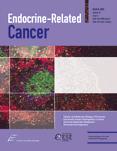Tabla de contenido
______________________________________________________________________________

Endocrine-Related Cancer.
Vol. 16, año 2009.
Commentary
- Epigenetics meets estrogen receptor: regulation of estrogen receptor by direct lysine methylation -Review
-DNA licensing as a novel androgen receptor mediated therapeutic target for prostate cancer
-The MPA mouse breast cancer model: evidence for a role of progesterone receptors in breast cancer
-Progesterone receptors act as sensors for mitogenic protein kinases in breast cancer models
-Resistance to chemotherapy and hormone therapy in endometrial cancer
- Cistromics of hormone-dependent cancer
- Clinical aspects of SDHx-related pheochromocytoma and paraganglioma
-Regular papers:Back -Azacitidine improves antitumor effects of docetaxel and cisplatin in aggressive prostate cancer models
- Evidence that androgen-independent stromal growth factor signals promote androgen-insensitive prostate cancer cell growth in vivo
-Analysis of signaling pathways related to cell proliferation stimulated by insulin analogs in human mammary epithelial cell lines
-c-FLIPL expression defines two ovarian cancer patient subsets and is a prognostic factor of adverse outcome
-Expression of the melanoma-associated antigen is associated with progression of human thyroid cancer
-Molecular characteristics of papillary thyroid carcinomas without BRAF mutation or RET/PTC rearrangement: relationship with clinico-pathological features
- Impairment of the p27kip1 function enhances thyroid carcinogenesis in TRK-T1 transgenic mice
-Polymorphisms of DNA damage response genes in radiation-related and sporadic papillary thyroid carcinoma
- Array-comparative genomic hybridization in sporadic benign pheochromocytomas
-Contrasting clinical manifestations of SDHB and VHL associated chromaffin tumours
-Pheochromocytomas and extra-adrenal paragangliomas detected by screening in patients with SDHD-associated head-and-neck paragangliomas
-Loss of neuronatin expression is associated with promoter hypermethylation in pituitary adenoma
-Hecate-CGß conjugate and gonadotropin suppression shows two distinct mechanisms of action in the treatment of adrenocortical tumors in transgenic mice expressing Simian Virus 40 T antigen under inhibin-{alpha} promoter
-Mutational analysis of the BRAF, RAS and EGFR genes in human adrenocortical carcinomas
-Microarray gene expression and immunohistochemistry analyses of adrenocortical tumors identify IGF2 and Ki-67 as useful in differentiating carcinomas from adenomas
-Prognostic factors influencing survival from metastatic (stage IV) gastroenteropancreatic well-differentiated endocrine carcinoma
-Obestatin stimulates Akt signalling in gastric cancer cells through ß-arrestin-mediated epidermal growth factor receptor transactivation
-Sonic hedgehog and pancreatic-duodenal homeobox 1 expression distinguish between duodenal and pancreatic gastrinomas
-High expression of gastrin-releasing peptide receptors in the vascular bed of urinary tract cancers: promising candidates for vascular targeting applications
- Increased expression of both insulin receptor substrates 1 and 2 confers increased sensitivity to IGF-1 stimulated cell migration
-Antizyme is necessary for conversion of pancreatic tumor cells into glucagon-producing differentiated cells
Reviews
• Emerging roles of chemokines in prostate cancer. Pág. 663-673
• Target-based therapies in breast cancer: current status and future perspectives. Pág. 675-702
• Mechanisms of bone metastases of breast cancer. Pág. 703-713
• New therapeutic advances in the management of progressive thyroid cancer. Pág. 715-731
• Radiation-induced hypopituitarism. Pág. 733-793 Research.
• Novel mechanism of IGF-binding protein-3 action on prostate cancer cells: inhibition of proliferation, adhesion, and motility. Pág. 795-808
• Regulation of thrombospondin- 1 by natural and synthetic progestins in human breast cancer cells. Pág. 809-917
• Estrogen regulation of vascular endothelial growth factor in breast cancer in vitro and in vivo: the role of estrogen receptor α and c-Myc. Pág. 819-834
• The aryl hydrocarbon receptor as a target for estrogen receptor-negative breast cancer chemotherapy. Pág. 835-844
• Hydrogen peroxide induces DNA single- and double-strand breaks in thyroid cells and is therefore a potential mutagen for this organ. Pág. 845-856
• The role of AUF1 in thyroid carcinoma progression. Pág. 857-871
• Impact of connexin32 deletion on E7 or RET/PTC3 oncogene-driven growth and neoplastic transformation of the thyroid gland. Pág. 873-884
• Midgut neuroendocrine tumours with liver metastases: results of the UKINETS study. Pág. 885-894
• Integrative molecular bioinformatics study of human adrenocortical tumors: microRNA, tissue-specific target prediction, and pathway analysis. Pág. 895-906
• Expression of excision repair cross complementing group 1 and prognosis in adrenocortical carcinoma patients treated with platinum-based chemotherapy. Pág. 907-918
• Glucose transporter GLUT1 expression is an stage-independent predictor of clinical outcome in adrenocortical carcinoma. Pág. 919-928
• Molecular characterization of novel germline deletions affecting SDHD and SDHC in pheochromocytoma paraganglioma patients. Pág. 929-937
• Hypermethylation of the IGF2 differentially methylated region 2 is a specific event in insulinomas leading to loss-of-imprinting and overexpression. Pág. 939-952
• High-resolution genomic profiling reveals gaqin of chromosome 14 as a predictor of poor outcome in ileal carcinoids. Pág. 953-966
• Circulating angiopoietin-2 is elevated in patients with neuroendocrine tumours and correlates with disease burden and prognosis. Pág. 967-976
• Clinical and imaging follow-up after exhaustive liver resection of endocrine metastases: a 15-year monocentric experience. Pág. 977-990
• Activation of a prometastatic gene expression program in hypoxic neuroblastoma cells. Pág. 991-1004
• Androgen, progesterone, and FSH receptor polymorphisms in ovarian cancer risk and outcome. Pág. 1005-1016
• Mammalian target of rapamycim inhibitors rapamycin and RAD001 (everolimus) induce anti-proliferative effects in GH-secreting pituitary tumor cells in vitro. Pág. 1017-1027
• Expression of aryl hydrocarbon receptor (AHR) and AHR-interacting protein in pituitary adenomas: pathological and clinical implications. Pág. 1029-1043
• Lanreotide promotes apoptosis and is not radioprotective in GH3 cells. Pág. 1045-1055
• Genome-wide scan identifies novel modifier loci of acromegalic phenotypes for isolated familial somatotropinoma. Pág. 1057-1063
 Salvar en InfomeDenlaceS
Salvar en InfomeDenlaceS
 RSS Artículo
RSS Artículo

